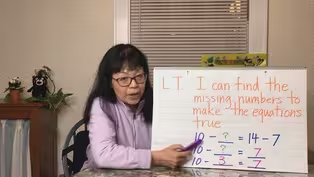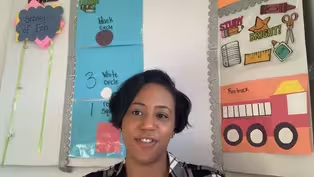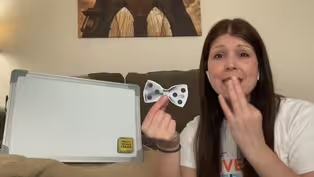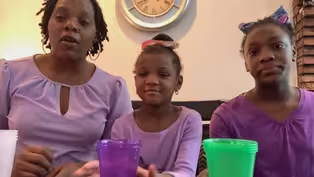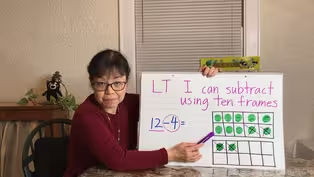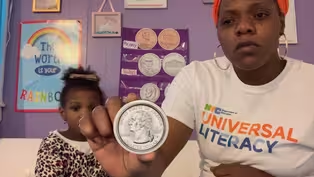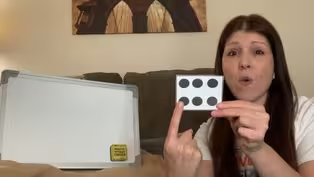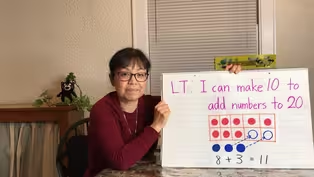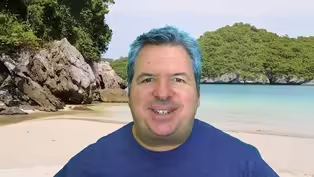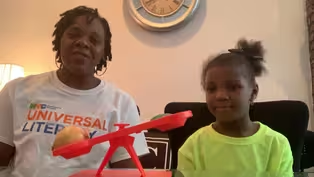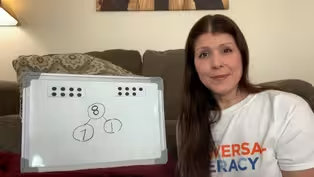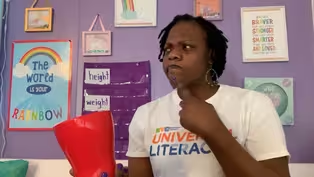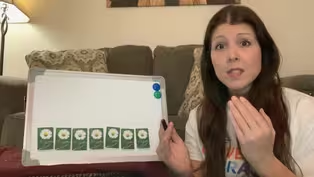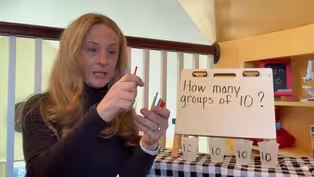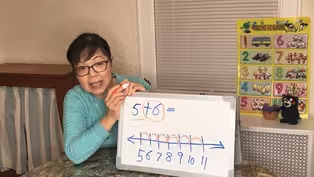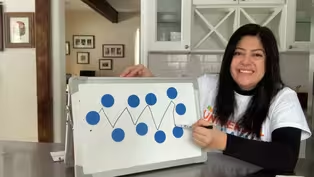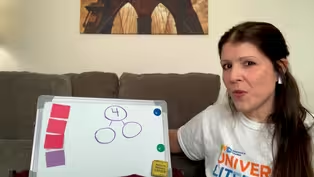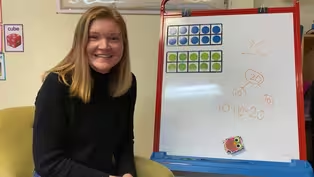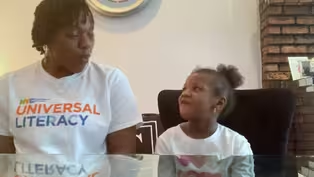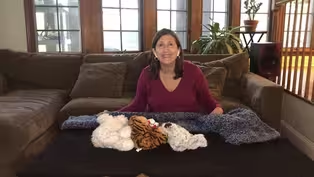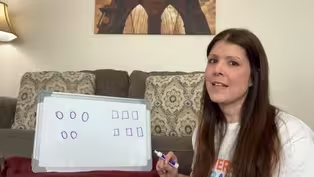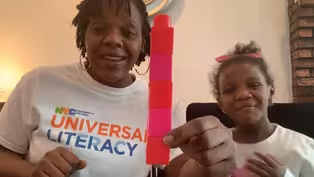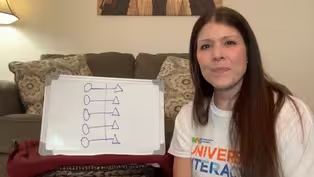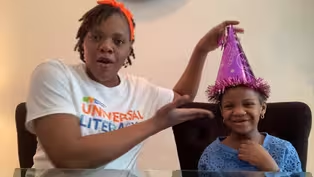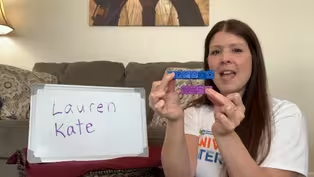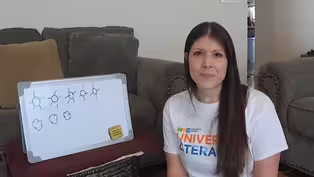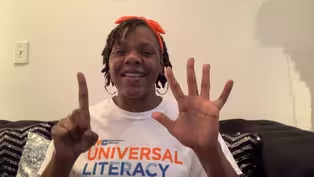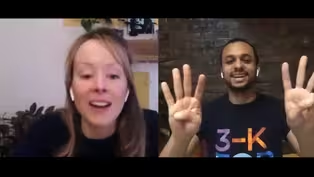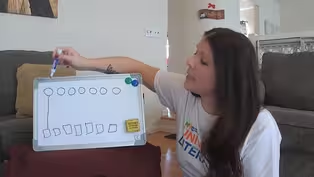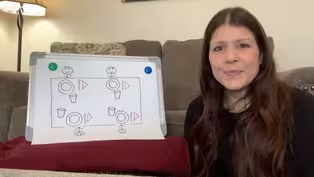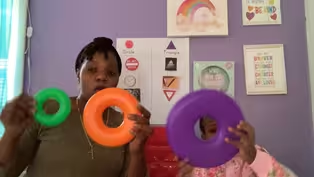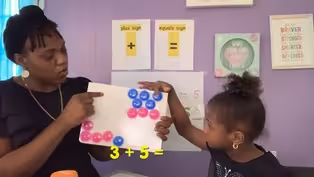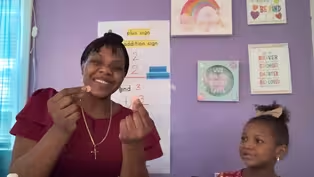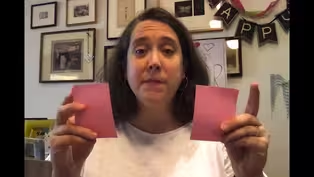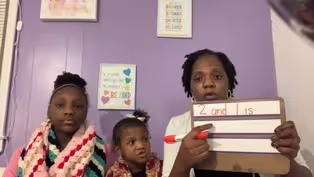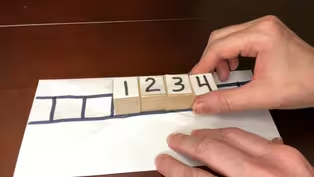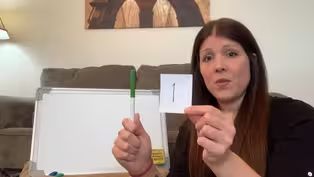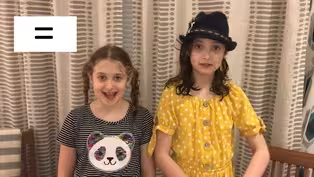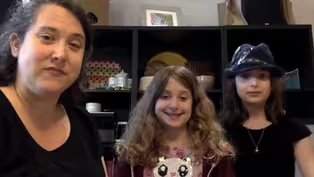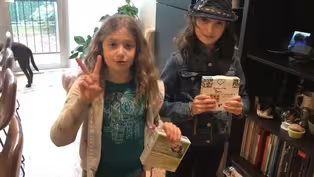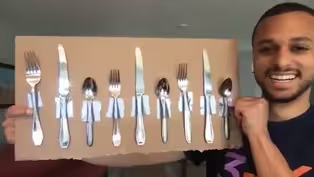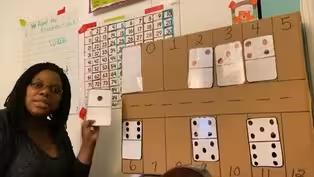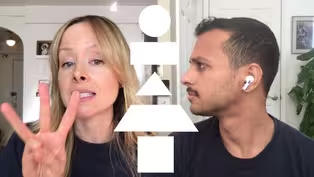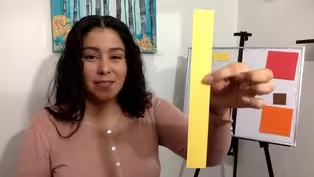
3D SHAPES
Clip: Special | 13m 44sVideo has Closed Captions
Lily Fincher and Omar Etman help students explore 3-D shapes.
Lily Fincher and Omar Etman help students explore 3-D shapes.
Problems playing video? | Closed Captioning Feedback
Problems playing video? | Closed Captioning Feedback
Let's Learn is a local public television program presented by THIRTEEN PBS

3D SHAPES
Clip: Special | 13m 44sVideo has Closed Captions
Lily Fincher and Omar Etman help students explore 3-D shapes.
Problems playing video? | Closed Captioning Feedback
How to Watch Let's Learn
Let's Learn is available to stream on pbs.org and the free PBS App, available on iPhone, Apple TV, Android TV, Android smartphones, Amazon Fire TV, Amazon Fire Tablet, Roku, Samsung Smart TV, and Vizio.
Providing Support for PBS.org
Learn Moreabout PBS online sponsorship[bright music] - Hi there, friends at home.
My name is Lily, and I'm so happy to be here with you today.
You know, I've been looking out my window out a lot, because it's still kind of cold here in New York City.
And I'm just so excited for the spring.
And as I was looking out my window, I realized that my window is a rectangle.
I know that because it has four straight sides.
It has four right corners, and the opposite sides are the same length.
Look around where you are.
Is there a rectangle nearby?
Hmm?
Well, that got me thinking about rectangles even more.
I looked to the side of me, and realized this wall is a rectangle.
That wall is a rectangle.
The wall in front of me is a rectangle, and the wall behind me is a rectangle.
And then I looked up.
The ceiling is a rectangle.
I looked down, the floor is a rectangle.
And all of these rectangles fit together.
They make a box.
I'm living in a box.
I wonder if Omar lives in a box, too.
Let's give him a call, and see.
Omar, Omar, Omar.
- Lily!
Hey!
It's good to see you.
- Hi, Omar, how are you, friend?
- I'm doing good, what's going on?
- Well, I was just thinking about how I live in a box, Omar.
All of the walls around me are rectangles.
The ceiling is a rectangle.
And the floor is a rectangle.
Do you live in a box, Omar?
- Well, let me see.
Yeah, the ceiling's a rectangle.
And the walls around me, rectangles.
And the floor, yeah, Lilly, I live in a box, too.
I'm in a box!
Huh?
This makes me think, Lily.
You and I have played a lot of games together, at home with rectangles, and other shapes.
But those have been flat shapes, like this.
- Yeah.
- But the box that we're inside of, made up of all these rectangles, that's something different.
That's a 3-D shape.
- 3-D?
Three Ds?
D, D, D?
- Yeah, sort of.
The D stands for dimension.
3-D objects have three dimensions, which means they aren't flat.
They fill up space.
Like this.
- Oh.
- See how it takes up space.
- Yes, I see.
Huh?
- Let me show you another 3-D object.
One that I think might help us understand.
So, this is a very famous 3-D object, that I actually, that I recently visited myself, here in Egypt.
Can you guess what it might be?
- Hmm, are there really famous boxes in Egypt?
- Well, it's not a box, it's another type of 3-D object.
It's a pyramid.
Do you know about the pyramids in Egypt?
- Omar, I have heard of these very famous 3-D shapes.
- Okay, let me tell you more about them.
So, they're enormous.
Look how small I am next to the Great Pyramid.
- Oh, my.
- I know.
Well, when I first walked up to it, when I first saw that pyramid, I saw a big triangle.
But then I started walking around it.
And I saw another triangle.
And then I walked a little more, another triangle.
And then I walked a little more, another triangle.
And I realized that pyramid that huge pyramid, is a 3-D object.
It's made up of many flat shapes.
All the triangles together, are on the sides.
And the square, at the bottom, they make the pyramid.
- So cool, Omar.
I really want to be visiting a pyramid.
- Well, Lily, you can.
And friends at home, you can, too.
Pretend you're here with me in Egypt.
Let's all pretend that we're inside a of pyramid.
Here, I'll show you how, stand up, stand up.
Okay, so we're going to imagine we're inside a pyramid.
So we have to draw the triangle walls around us.
Draw the first wall.
One.
Two.
Three.
Four.
And Lily, don't forget the square floor underneath you.
Okay, now we're inside of our pyramid.
Let's dance.
And friends at home, be careful not to hit your head on the sloping walls.
[lively dance music] - Omar, that was so fun.
I loved dancing in my pyramid.
And as I was dancing, Omar, I was thinking, there's a very famous building nearby, where I live in New York City, that I think is one of these special 3-D shapes that you're talking about.
Let me show you, and I wonder if you can guess what it is.
- Lily!
That's the Flat Iron building in New York.
- It is!
- I love that building.
I used to walk by it all the time.
Okay, so this is a 3-D object.
So I see that it has flat shapes on every face of the building.
I see the long rectangle on one side.
And a long rectangle on the other side.
And, I can guess, I'm pretty sure that there's another long rectangle on the back.
And then, there's a triangle on the top and the bottom.
Lily, the Flat Iron Building, it's a different type of 3-D object.
It's a triangular prism.
- Oh, triangular prism?
- Yeah, so far we explored a few types of 3-D objects.
We've explored pyramids, and triangular prisms.
- Oh, and weren't we also talking about boxes?
- Oh, yes, yes.
- Is that a special 3-D object?
- Yeah, great job, Lily.
A box is a rectangular prism.
- Oh.
- You know, Lily, there are big 3-D objects all around us.
Like the pyramids, like the Flat Iron Building.
But there also smaller 3-D objects, right in our very homes.
- Wait, there's 3-D objects all around me?
- Yes, Lily, just like the box that you're in, they're all around you.
And I have a game that will help us find them.
It's called "3-D Shape Scavenger Hunt".
[triumphant music] [excited children shouting] This game, Lily, helps us find the shapes, that make up 3-D objects.
So, here's how we'll play.
I'll show you a shape face, and then both of us will go searching to see if we can find a 3-D object that has that shape, as one of it's faces.
Friends at home, you can play, too.
We'll all look for objects that have the same shape face.
It's a fun, 3-D shape scavenger hunt.
- Oh, sounds great, Omar.
I'm ready to play.
- Okay, our first shape is a circle.
[bell ringing] When I say go, find a 3-D shape that has a circle face.
Ready, set, go!
[lively music] Okay, Lily, what did you find?
What 3-D object did you find that has a circle shape?
- All right, I found this canister, which has a circle on the top, and a circle on the bottom.
I found this candle.
It also has a circle on the top.
And a circle on the bottom.
And then, I realized, my yoga mat, when it's rolled up, there's a circle on this side, and a circle on this side.
What about you?
- Whoa, Lily, you found so many, Lily, great job.
I found in the kitchen, this can.
Which has a circle on the top.
And a circle on the bottom.
You know, Lily, these 3-D objects that we found, the ones that have circles, they have a special name, too.
These are cylinders.
- Ah, cylinders, cool, Omar.
Okay, I'm ready to find a new shape.
- Okay, here we go.
Find a 3-D shape somewhere around you, that has a triangle face.
[bell ringing] Ready, set, go.
[lively music] Lily's still searching, let's see what she finds.
Lily, tell me, tell me.
What 3-D object did you find with a triangle face?
- That was kind of hard, Omar.
But I realized this candle holder has a triangle on the bottom, and a triangle on the top.
But rectangles on the sides.
And then, I found this thing that my candle was in.
There's a triangle on every side.
Omar, I think this is like that pyramid that you were telling me about.
- Yeah, Lily, you found two different types of 3-D objects.
You found a pyramid, and a triangular prism.
Really good job.
You know, I have to say.
I didn't, I wasn't able to find any 3-D objects with a triangle face.
It's kind of hard.
But if I find one, I'll show you later.
Okay, okay, let's search for our final 3-D shape.
Lily, friends at home, find a 3-D shape that has a rectangle face.
[bell ringing] Ready, set, go.
[lively music] - What did you find?
- Okay, Omar, you know, this book is definitely a rectangle.
And when I move it, and look at the sides, there's rectangles on every side.
And then I found these two boxes.
One is quite long, and one's a little shorter.
They have many rectangle sides.
And they have two sides that have a special type of rectangle, a square.
What did you find, Omar?
- Okay, I found this box of face masks.
Which has a rectangle on every side.
I also found this piece of chocolate.
Which has a rectangle on every face.
- Oh, I love it, Omar, this is so fun, searching for these shapes.
But you know what, Omar?
I just feel like I wanna dance.
- Let's dance, then.
And I have an idea.
When we're dancing, why don't we each pick a type of 3-D shape that we'll dance inside.
Friends at home, you do the same.
Ready, let's dance.
[lively dance disco music] - Omar, it always feels great to dance with you.
- Ah, it really does.
Lily, I noticed you were dancing in a lot of circle patterns, spinning and spinning.
Were you dancing inside of a cylinder?
- You know I was.
What about you?
What were you dancing in?
- I was dancing in a rectangular prism.
I was trapped in a box.
Lily, thanks so much for playing with me today.
And friends at home, keep a look out for 3-D objects, big and small, all around you.
Pay attention to the faces on the 3-D objects.
What face do you see?
And if you want, you can turn it into a fun scavenger hunt game, like we did.
- Thanks so much, Omar.
That was so fun, I learned so much about 3-D shapes.
And thank you for playing with us, friends at home.
Remember, math is all around you.
Go see what math you can find today.
- Bye, bye, Omar.
- Bye, Lilly.
Bye, everyone.
Video has Closed Captions
Clip: Special | 15m 17s | Yasuko Yamaguchi helps students find missing numbers to make equations true. (15m 17s)
EXPLORING NUMBERS AND ORAL COUNTING
Video has Closed Captions
Clip: Special | 9m 12s | Shana Davis helps students explore numbers 0-5. (9m 12s)
Video has Closed Captions
Clip: Special | 15m 15s | Lauren Olivieri helps students learn all about the number 10. (15m 15s)
Video has Closed Captions
Clip: Special | 12m 3s | Trinettte Carruthers helps students add 3 numbers in 3 different ways. (12m 3s)
Video has Closed Captions
Clip: Special | 11m 38s | Yasuko Yamaguchi helps students subtract using 10 frames. (11m 38s)
Video has Closed Captions
Clip: Special | 15m 11s | Trinette Carruthers introduces students to a coins and their value. (15m 11s)
Video has Closed Captions
Clip: Special | 12m 25s | Lauren Olivieri helps students decompose the number 9. (12m 25s)
Video has Closed Captions
Clip: Special | 10m 54s | Yasuko Yamaguchi helps students add numbers to 20. (10m 54s)
Video has Closed Captions
Clip: Special | 6m 31s | Steve Sherman from MoMath helps students count shells. (6m 31s)
Video has Closed Captions
Clip: Special | 7m 33s | Trinette Carruthers helps students to compare weights of objects with a pan balance. (7m 33s)
Video has Closed Captions
Clip: Special | 12m 23s | Lauren Olivieri helps student learn about different ways to decompose the number 8. (12m 23s)
DESCRIBE OBJECTS BY THEIR ATTRIBUTES
Video has Closed Captions
Clip: Special | 11m 4s | Trinette Carruthers helps students describe objects by their attributes. (11m 4s)
Video has Closed Captions
Clip: Special | 12m 54s | Lauren Olivieri helps students represent the number 7 in various ways. (12m 54s)
Video has Closed Captions
Clip: Special | 11m 47s | Nicole Treanor helps students count 10-20 objects from around their home. (11m 47s)
Video has Closed Captions
Clip: Special | 6m 39s | Trinette Carruthers explores the comparative capacity of different sized containers. (6m 39s)
Video has Closed Captions
Clip: Special | 11m 17s | Yasuko Yamaguchi helps students add two numbers using an open number line. (11m 17s)
Video has Closed Captions
Clip: Special | 10m 57s | Layla Munson helps students count to 10 in different ways (10m 57s)
Video has Closed Captions
Clip: Special | 13m 57s | Lauren Olivieri helps students learn different ways to make the number 6. (13m 57s)
Video has Closed Captions
Clip: Special | 11m | Courtney Colletta explores teen numbers. (11m)
Video has Closed Captions
Clip: Special | 8m 30s | Trinette Carruthers and her daughter compare objects by length and height. (8m 30s)
ON AND OFF THE BUS (TRANSPORTATION NUMERACY)
Video has Closed Captions
Clip: Special | 13m 28s | Jenny Ottinger explores numeracy as stuffed animals get on and off a cardboard box bus. (13m 28s)
Video has Closed Captions
Clip: Special | 13m 47s | Lauren Olivieri helps students create sets that have 1 more. (13m 47s)
Video has Closed Captions
Clip: Special | 10m 37s | Trinette Carruthers and her daughter explore a variety of patterns. (10m 37s)
CREATE SETS WITH THE SAME NUMBER
Video has Closed Captions
Clip: Special | 13m 53s | Lauren Olivieri helps students create sets of objects that have the same number. (13m 53s)
Video has Closed Captions
Clip: Special | 7m 40s | Trinette Carruthers and her daughter help students identify solid figures. (7m 40s)
PRACTICE MORE, LESS, AND SAME!
Video has Closed Captions
Clip: Special | 12m 47s | Lauren Olivieri helps learn more/less/same by creating a shape picture. (12m 47s)
COMPARE USING "FEWER THAN" AND "SAME AS"
Video has Closed Captions
Clip: Special | 12m 25s | Lauren Olivieri compares quantities using “fewer than” and “same as.” (12m 25s)
Video has Closed Captions
Clip: Special | 8m 44s | Trinette Carruthers helps students identify hexagons. (8m 44s)
Video has Closed Captions
Clip: Special | 12m 22s | Lily Fincher and Omar Etman play a game to help children develop a mental number line. (12m 22s)
Video has Closed Captions
Clip: Special | 12m 22s | Lily Fincher and Omar Etman play a game to help children develop a mental number line. (12m 22s)
COMPARE USING "MORE THAN" AND "SAME AS"
Video has Closed Captions
Clip: Special | 12m 11s | Lauren Olivieri helps students compare using “more than” and “same as.” (12m 11s)
COMPARE TO SEE IF THERE ARE ENOUGH
Video has Closed Captions
Clip: Special | 14m 1s | Lauren Olivieri helps students match objects to numbers as they pretend to set a table. (14m 1s)
IDENTIFY CIRCLES AND TRIANGLES
Video has Closed Captions
Clip: Special | 10m 21s | Trinette Carruthers helps students identify circles and triangles. (10m 21s)
WRITE EQUATIONS TO SHOW ADDITION
Video has Closed Captions
Clip: Special | 11m 31s | Trinette Carruthers and her daughter help students write equations to show addition. (11m 31s)
USE + TO WRITE AN ADDITION EXPRESSION!
Video has Closed Captions
Clip: Special | 11m 16s | Trinette Carruthers help students use the plus sign to write an addition expression. (11m 16s)
Video has Closed Captions
Clip: Special | 13m 6s | Rachel Benoff and her daughters help students understand fractions. (13m 6s)
Video has Closed Captions
Clip: Special | 13m 10s | Trinette Carruthers and her daughters help students write addition sentences. (13m 10s)
Video has Closed Captions
Clip: Special | 11m 56s | Liz McDonald prompts students to practice counting with trains. (11m 56s)
Video has Closed Captions
Clip: Special | 13m 54s | Lauren Olivieri helps students count and compare groups of objects from 1-10. (13m 54s)
WHAT DOES THE EQUAL SIGN MEAN?
Video has Closed Captions
Clip: Special | 12m 27s | Rachel Benoff and her daughters explore the meaning of the equal sign. (12m 27s)
Video has Closed Captions
Clip: Special | 12m 1s | Krista Kaiser and Helen Poje show students how to play math games. (12m 1s)
Video has Closed Captions
Clip: Special | 15m 37s | Lily Fincher and Omar Etman help students learn spatial language. (15m 37s)
Video has Closed Captions
Clip: Special | 11m 5s | Rachel Benoff and her daughters explore number bonds. (11m 5s)
WHAT IS ADDITION? WHAT IS SUBTRACTION?
Video has Closed Captions
Clip: Special | 12m 12s | Rachel Benoff and her daughters explore addition and subtraction. (12m 12s)
Video has Closed Captions
Clip: Special | 12m 55s | Rachel Benoff helps students determine if groups of objects are equal or unequal. (12m 55s)
Video has Closed Captions
Clip: Special | 11m 51s | Lily Fincher and Omar Etman help students learn about the core unit in patterns. (11m 51s)
Video has Closed Captions
Clip: Special | 15m 37s | Glenda Esperance helps students to build math skills playing “domino parking lot. (15m 37s)
Video has Closed Captions
Clip: Special | 13m 28s | Lily Fincher and Omar Etman show students how to make images of vehicles from shapes. (13m 28s)
Video has Closed Captions
Clip: Special | 19m 22s | Damaris Rosado-James shows students how to sort shapes by their attributes. (19m 22s)
Video has Closed Captions
Clip: Special | 13m 45s | Shana Davis leads students on a scavenger hunt for shapes in household items. (13m 45s)
Providing Support for PBS.org
Learn Moreabout PBS online sponsorshipSupport for PBS provided by:
Let's Learn is a local public television program presented by THIRTEEN PBS
